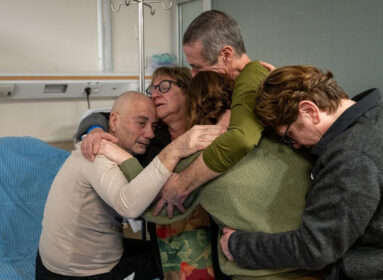New Britain museum highlights Jewish photographer
By Cindy Mindell
NEW BRITAIN – Photographer Fern Berman still remembers the feel of the manuscript smuggled out of Terezin, the collection of cherished recipes recounted by women who perished in the camp. The fragile pages had survived a 50-year journey from post-war Czechoslovakia to Israel to Ohio to New York, eventually landing in the hands of Anny Stern, whose mother, Mina Pachter, had collected the recipes before succumbing to starvation.
In 1996, the manuscript was transformed into the celebrated book, In Memory’s Kitchen: A Legacy from the Women of Terezin. Berman was part of the team who worked pro bono on what they called “the mitzvah project,” led by editor Cara De Silva.
Berman was heading Fern Berman Communications at the time, handling public relations for renowned chefs and restaurateurs. “I held the manuscript in my hands before it went to the Smithsonian,” she recalls. “I did the publicity for the book as a mitzvah because I knew how important it was.”
This sense of the significance is what guides Berman in her artistic work as well. A collection of the photographer’s color- and texture-saturated prints, “NEW/NOW: Fern Berman,” is on exhibit at the New Britain Museum of American Art through Jan. 5, 2014. The images often portray crumbling and neglected bits of landscape, made beautiful by Berman’s insistence that they be noticed. Her message: just take a good look.
Born in Brooklyn, N.Y. in 1958, Berman was raised in Merrick, Long Island in a home that encouraged her interest in art. She drew and painted, experimenting with oil paints, watercolors, and pastels. She learned about color and technique from the printing world: her grandfather printed on a letterpress; her father ran a commercial web press.
Berman’s artistic influences are the painters she first met in museums and homes around the world: Mark Rothko, Henri Matisse, and the artists of the Der Blaue Reiter movement in pre-World War One Germany – Paul Klee, Lyonel Feininger, Wassily Kandinsky, Gabrielle Munter, and her biggest influence, Franz Marc. From Kandinsky’s work, she learned that color can take on a spiritual dimension.
When she was 12, Berman’s parents gave her a Konica camera, and soon her photos were appearing regularly in local newspapers.
Berman’s art is also marked by her personal history. One side of her family fled the pogroms in Belarus, where her grandfather saw his family killed before escaping with a surviving sister. In Sunday school, which Berman attended until she was 17, a teacher showed Holocaust-themed films every week. As an adult, she visited Terezin on the final day of the last of many trips to Germany. “That affected me and I think it changed the way I look at the world,” she says. “All of that sits in my body and my soul when I shoot.”
She studied photography at the Art Institute of Boston and the School of Visual Arts in New York City. While her early first photographs explored black and white images and the effects of shadows, her work evolved to focus on the examination of color and pattern. She taught in New York at the School of Visual Arts and NYU. She eventually left Manhattan for Madison, where she became involved in the Jewish community of Greater New Haven.
Her work is informed by the aromas of art, as well: the ink of the printing presses, the fixer in the darkroom – she calls it “one of my favorite fragrances” – and early memories of standing, in museums, “close enough to see the brushstrokes of the artist and try to see if I could smell the oil paint,” she says.
For Berman, capturing an image isn’t as simple as looking through her lens. She has multiple sclerosis, “which has been a gift in a way,” she says, “because it slowed me down and I can’t just run and shoot.”
Instead, she observes potential subjects for months, even years, passing by, passing again, getting up close. Some make it onto her film – her sole photographic medium – and some don’t.
“I still shoot film because I feel that you get much more depth of color, unlike digital,” she says. “Digital took away my soul, and soul is part of my work. I like the 36 pictures in the roll – two times chai! I like the limitations: every picture has to count, and in digital, it doesn’t.”
Berman wants to use her work to awaken a sense of wonder in others. “I really feel that being Jewish definitely helps me see because I look at things differently,” she says. “I never tell people what they’re looking at because then they’ll have preconceived notions. What I don’t want is for people to look and walk away, but instead to look at one of my photographs as a painting and stand in front of it and contemplate it. I wake up in the morning and know what Abraham Joshua Heschel meant when he talked about living life ‘in radical amazement:’ everything is incredible.”
“NEW/NOW: Fern Berman:” through Jan. 5, 2014, New Britain Museum of American Art, 56 Lexington St., New Britain. Info: nbmaa.org; (860) 229-0257.







 Southern New England Jewish Ledger
Southern New England Jewish Ledger













